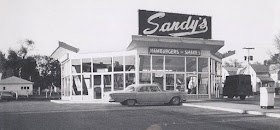In 1956, four men set out to start one of the first McDonald's franchises outside the McDonald brothers' home state of California. Ray Kroc had just begun selling McDonald's franchises outside California, and the four friends partnered to buy the right to open McDonald's restaurants in central Illinois.
 In June 1956, they opened their first restaurant in Urbana, Illinois, only the third McDonald's restaurant to open outside California. The Urbana store proved popular with students, professionals, and young families at the University of Illinois. It did so well that the group decided to open additional McDonald's restaurants in Decatur and Peoria, Illinois.
In June 1956, they opened their first restaurant in Urbana, Illinois, only the third McDonald's restaurant to open outside California. The Urbana store proved popular with students, professionals, and young families at the University of Illinois. It did so well that the group decided to open additional McDonald's restaurants in Decatur and Peoria, Illinois.However, Ray Kroc notified them that Peoria and Decatur were not included in the central Illinois territory. Furthermore, that changed the terms of the franchise contract, which meant they would owe a higher percentage of their profits to McDonald's. Having invested heavily in the Peoria location, including erecting the building, the partners decided instead to open their own restaurant and settled on the name Sandy's.
Sandy's chain adopted a Scottish-based theme to combat the Scottish-rooted McDonald's, even though the latter was not based on a cultural theme of any kind.


- Operators of most restaurants owned their stores and did not lease from the corporation.
- Operators were not required to buy supplies from the corporation; instead, they were permitted to "shop around" as long as the supplies met company standards.
- Lundberg visited every store periodically and became personally acquainted with every employee.
 |
| An Employee. |
Meanwhile, the successful Hardee's chain in the Southern U.S. (founded by Wilbur Hardee) had money and was looking to expand its operations. Hardee's solution was a merger.
On November 30, 1971, it was announced that Hardee had purchased all of Sandy's Drive-In stock. The plaid berets of Sandy's were soon gone. Sandy's had expanded to Belgium and Canada before being dismantled.
Originally, Sandy's was to merge with Hardees but maintain its own identity. In 1973, ninety percent of Sandy's locations agreed to switch to Hardee's; the rest remained Sandy's restaurants.
By 1979, the last Sandy's location in Muscatine, Iowa, became a Hardees. Any remaining locations went under independent ownership and changed their names to avoid infringing on Sandy's name:
These locations included Zandy's in Great Falls, Montana, until it closed in January 2009 after a break-in and declining profits; Sandie's in Billings, Montana; Andy's in Cincinnati, Ohio; and Bucky's in Lawrence, Kansas, until it closed on December 14, 2007.
Illinois Locations:
- Addison
- Aurora
- Belleville
- Benton
- Bloomington
- Bolingbrook
- Canton
- Champaign
- Charleston
- Collinsville
- Creve Coeur
- Decatur
- DeKalb
- Dixon
- East Alton
- Elmhurst
- Freeport
- Galesburg
- Geneseo
- Hillside
- Jacksonville
- Kankakee
- Kewanee
- Macomb
- Mattoon
- Moline
- Monmouth
- Mt. Vernon
- Normal
- Pekin
- Peru
- Peoria
- 401 South Western Avenue, West Peoria
- 423 Main Street, Peoria
- 4419 North Prospect Road, Peoria Heights
- 200 West McClure Avenue, Sandy's Thrift & Swift Drive-In, Peoria
- Quincy
- Rock Island
- Rockford
- Springfield
- Sterling
- Streator
- Urbana

























Compiled by Dr. Neil Gale, Ph.D.












Dr. Neil Gale, Thanks for posting! Nice article and I love those old pictures! I noticed you have at least one town missing on your Illinois list: Mount Vernon. There was a Sandy's location at 1918 W. Broadway St in Mt. Vernon, Illinois. I don't know when it was opened (possibly late 1960s) , but it was active in the summer of 1977 when I moved to Mt. Vernon. It was located across the street from the Casey Junior High School. Sometime in the 1977 to 1979 time period it became a HARDEE'S restaurant. The Hardee's eventually closed (don't know when) but the building is now (as of September 2023) a used car lot called "AUTO MART".
ReplyDeleteMissing the Macomb, IL location, built in late 1960s.
ReplyDeleteI was the first recipient of the Gus E Lundberg Award at WIU (given for leadership , graduating senior)
Also missing Monmouth il location 400 block of North main st.
ReplyDeleteThere was also a Sandy's in Chicago, on Archer Avenue, in the neighborhood called Garfield Ridge (Midway airport area)
ReplyDeleteThere was one in Centralia as well. The Hardees that it became just permanently closed today.
ReplyDelete